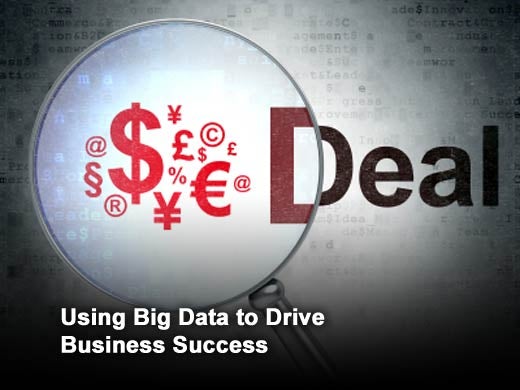Companies can achieve Big Data success by starting small and focusing on the highest leverage opportunities, which can usually be found in sales and pricing strategies. Successful Big Data applications should be able to answer key questions that fall under the business intelligence umbrella (such as, “How do I sell more products to an existing customer?” or “Can I extract a higher price for this specific transaction?”). The ability to answer these questions with Big Data insights can help organizations respond more quickly to their customers, and also enable them to drive sales volumes and increase revenue. Here are seven ways, identified by PROS, to change Big Data from a buzz word to an actionable opportunity.
Click through for seven ways to make Big Data an actionable opportunity for business, as identified by PROS.
Big Data is about connected data, piecing together multiple and separate data points to identify patterns that help predict outcomes and prescribe actions – automatically. When considering a Big Data software suite, make sure it has an analytical component to it, so you are getting “smart” data.
Companies that embrace and invest in Big Data will outperform their competitors in every available financial metric. For example, in 2009, drilling activities plummeted across the board. One global oilfield services company was facing challenges similar to its competitors, including insurmountable profitability losses due to the instability of the oilfield business. In addition, fluctuations in market demand were causing inconsistent data sources resulting in imprecise pricing. After implementing segmentation and using Big Data science to forecast demand, the company generated $200 million in incremental sales over a two-year period, enabling them to outperform the market.
Big Data science must include an assessment of data viability to provide more accurate and reliable insights than generic analytics or business intelligence. With so many varieties of data and variables to consider in building an effective predictive model, companies should quickly and cost-effectively test and confirm a particular variable’s relevance before investing in the creation of a fully featured model.
Big Data only matters if it results in better outcomes, not just better insights. For example, in the midst of health care reform, medical device manufacturers have experienced excruciating pressures from hospital purchasing organizations looking to reduce their costs. Using its Big Data, one company’s sales team was able to show the purchasing organization its calculations on how to evaluate pricing. The result: a 6 percent increase in average selling price in four quarters, and the highest margin in three years.
The most valuable and measurable outcomes are those associated with sales growth, profitability and competitive positioning. For example, one large chemical manufacturer began experiencing declining revenue for one of its burgeoning businesses and recognized a series of unaligned business processes. Working with its planning department, it used Big Data to shape a new demand curve for where products should be shipped to satisfy customer requirements. It was also able to use data science to identify prescriptive pricing guidance for the sales team. Revenue increased by $200 million in the first year alone.
Insights come from Big Data science; outcomes come from Big Data applications infused with data science. This is Big Data nirvana. For example, one international storage and information management company saw its incremental revenue level off. It faced issues including stick rates and miscommunication between the pricing department and the sales teams. As a result, it was having trouble meeting specific targets. Thanks to Big Data science and prescriptive pricing guidance, it was able to identify specific attributes imperative in determining customers’ willingness to pay. Thanks to these insights, the company realized that a sizeable number of contracts were priced far below market price. Not only has it seen some really impressive data, it’s also seen a reduction in customer terminations and improved statistics.
Big Data applications are the future of Big Data because they provide the execution arm of technology, not just insights. One example of this type of application is price guidance, which is a technique that delivers a set of pricing recommendations to the sales person, including details on deals most likely to close, products that are most likely to sell, and prices that are most likely to win. It hides most of the back-end complexity associated with Big Data and price optimization.










